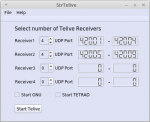Hi welshevo,
I've long wanted to make this a reality with a Pi as it would make it a very portable option with a standard RTL stick. Unfortunately Telive needs quite a bit of CPU horsepower.
I originally tried running it in (bare metal) Debian Linux on an HP Mini netbook with Intel Atom 1.6 CPU and 2GB RAM.
It struggled badly and the audio was very very choppy.
I then tried it on an AMD 2.4Ghz laptop, 2GB RAM running on a Debian VM inside VirtualBox on top of Windows 7.
This also struggled although not as badly and I put it down to being on a VM.
I then rebuilt the same AMD laptop with bare metal Debian Linux, set it all up on that and it runs fine.
I've since gone back to the VM option on a much more powerful laptop for convenience and its fine this time.
So, given that even the latest Pi (3) is a quad core 1.2GHz with 1GB RAM, I think it would struggle...
It is a real shame and I wish it would work too

anyone?


